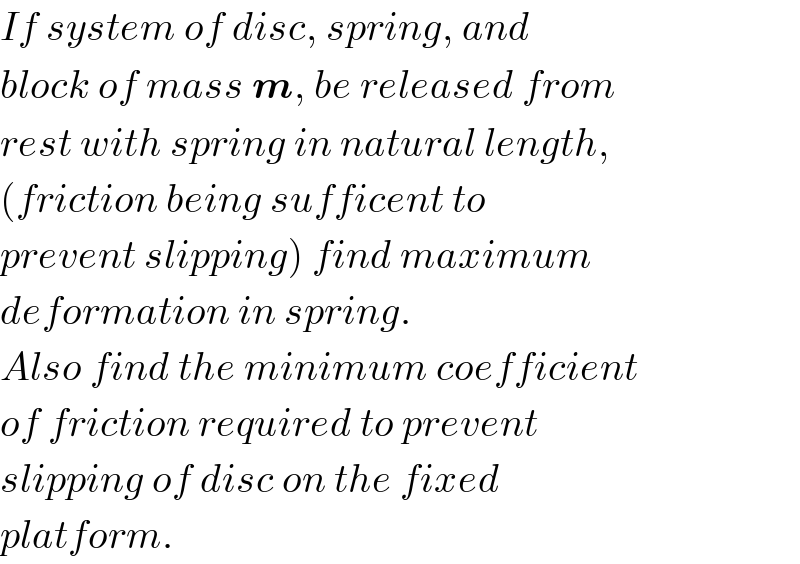
Question and Answers Forum
Question Number 28113 by ajfour last updated on 20/Jan/18

Commented by ajfour last updated on 20/Jan/18

Answered by mrW2 last updated on 21/Jan/18
![x_1 =displacement of block a_1 =acceleration of block=(d^2 x_1 /dt^2 ) x_2 =displacement of disc a_2 =acceleration of disc=(d^2 x_2 /dt^2 ) T=force in spring e=deformation in spring=x_1 −x_2 Spring: T=ke=k(x_1 −x_2 ) ⇒(d^2 T/dt^2 )=k(a_1 −a_2 ) Block: mg−T=ma_1 ⇒a_1 =g−(T/m) Disc: TR=I_2 α_2 =(((mR^2 )/2)+mR^2 )×(a_2 /R)=((3mR)/2)×a_2 ⇒a_2 =((2T)/(3m)) ⇒(d^2 T/dt^2 )=k(a_1 −a_2 )=k(g−(T/m)−((2T)/(3m)))=(k/m)(mg−((5T)/3)) ⇒(d^2 T/dt^2 )=(k/m)(mg−((5T)/3)) let S=mg−((5T)/3) (d^2 S/dt^2 )=−(5/3)×(d^2 T/dt^2 ) ⇒−(3/5)(d^2 S/dt^2 )=(k/m)S ⇒(d^2 S/dt^2 )+((5k)/(3m))S=0 ⇒S=c_1 sin ωt+c_2 cos ωt with ω=(√((5k)/(3m))) ⇒T=(3/5)(mg−S)=(3/5)(mg−c_1 sin ωt−c_2 cos ωt) ⇒(dT/dt)=(3/5)(−c_1 cos ωt+c_2 sin ωt)ω at t=0: T=0 and (dT/dt)=k(v_1 −v_2 )=0 mg−c_2 =0⇒c_2 =mg ⇒c_1 =0 ⇒T=((3mg)/5)(1− cos ωt) ⇒T_(max) =((6mg)/5) at ωt=(2n−1)π or t=(2n−1)π(√((3m)/(5k))) ⇒e_(max) =((6mg)/(5k)) T−f=ma_2 f=T−ma_2 =T−((2T)/3)=(T/3)≤μmg ⇒μ≥(T_(max) /(3mg))=((6mg)/(3×5mg))=(2/5)=0.4 a_1 =g−((3g)/5)(1−cos ωt)=(g/5)(2+3cos ωt) v_1 =(g/5)(2t+(3/ω)sin ωt) ⇒x_1 =(g/5)[t^2 +(3/ω^2 )(1−cos ωt)] a_2 =((2g)/5)(1−cos ωt) ⇒v_2 =((2g)/5)(t−(1/ω)sin ωt) ⇒x_2 =(g/5)[t^2 −(2/ω^2 )(1−cos ωt)] we see the system is in vibration. the force in spring varies between 0 and ((6mg)/5), about the mean value ((3mg)/5). after the vibration is vanished, the force in spring remains constant, the spring acts as normal string, block and disc have the same acceleration: a_1 =a_2 g−(T/m)=((2T)/(3m)) ⇒T=((3mg)/5)=mean value of vibration ⇒e=((3mg)/5)](Q28133.png)
Commented by ajfour last updated on 21/Jan/18

| ||
Question and Answers Forum | ||
Question Number 28113 by ajfour last updated on 20/Jan/18 | ||
 | ||
Commented by ajfour last updated on 20/Jan/18 | ||
 | ||
Answered by mrW2 last updated on 21/Jan/18 | ||
![x_1 =displacement of block a_1 =acceleration of block=(d^2 x_1 /dt^2 ) x_2 =displacement of disc a_2 =acceleration of disc=(d^2 x_2 /dt^2 ) T=force in spring e=deformation in spring=x_1 −x_2 Spring: T=ke=k(x_1 −x_2 ) ⇒(d^2 T/dt^2 )=k(a_1 −a_2 ) Block: mg−T=ma_1 ⇒a_1 =g−(T/m) Disc: TR=I_2 α_2 =(((mR^2 )/2)+mR^2 )×(a_2 /R)=((3mR)/2)×a_2 ⇒a_2 =((2T)/(3m)) ⇒(d^2 T/dt^2 )=k(a_1 −a_2 )=k(g−(T/m)−((2T)/(3m)))=(k/m)(mg−((5T)/3)) ⇒(d^2 T/dt^2 )=(k/m)(mg−((5T)/3)) let S=mg−((5T)/3) (d^2 S/dt^2 )=−(5/3)×(d^2 T/dt^2 ) ⇒−(3/5)(d^2 S/dt^2 )=(k/m)S ⇒(d^2 S/dt^2 )+((5k)/(3m))S=0 ⇒S=c_1 sin ωt+c_2 cos ωt with ω=(√((5k)/(3m))) ⇒T=(3/5)(mg−S)=(3/5)(mg−c_1 sin ωt−c_2 cos ωt) ⇒(dT/dt)=(3/5)(−c_1 cos ωt+c_2 sin ωt)ω at t=0: T=0 and (dT/dt)=k(v_1 −v_2 )=0 mg−c_2 =0⇒c_2 =mg ⇒c_1 =0 ⇒T=((3mg)/5)(1− cos ωt) ⇒T_(max) =((6mg)/5) at ωt=(2n−1)π or t=(2n−1)π(√((3m)/(5k))) ⇒e_(max) =((6mg)/(5k)) T−f=ma_2 f=T−ma_2 =T−((2T)/3)=(T/3)≤μmg ⇒μ≥(T_(max) /(3mg))=((6mg)/(3×5mg))=(2/5)=0.4 a_1 =g−((3g)/5)(1−cos ωt)=(g/5)(2+3cos ωt) v_1 =(g/5)(2t+(3/ω)sin ωt) ⇒x_1 =(g/5)[t^2 +(3/ω^2 )(1−cos ωt)] a_2 =((2g)/5)(1−cos ωt) ⇒v_2 =((2g)/5)(t−(1/ω)sin ωt) ⇒x_2 =(g/5)[t^2 −(2/ω^2 )(1−cos ωt)] we see the system is in vibration. the force in spring varies between 0 and ((6mg)/5), about the mean value ((3mg)/5). after the vibration is vanished, the force in spring remains constant, the spring acts as normal string, block and disc have the same acceleration: a_1 =a_2 g−(T/m)=((2T)/(3m)) ⇒T=((3mg)/5)=mean value of vibration ⇒e=((3mg)/5)](Q28133.png) | ||
| ||
Commented by ajfour last updated on 21/Jan/18 | ||
 | ||